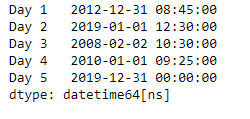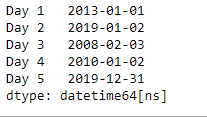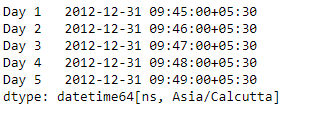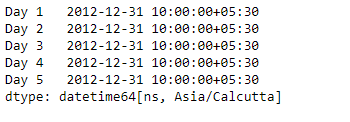Python Pandas Series.dt.ceil
Series.dt可以用来访问类似于数据时间的系列值,并返回若干属性。Pandas Series.dt.ceil()函数对数据进行ceil操作,以指定的频率。
语法: Series.dt.ceil(*args, **kwargs)
参数:
freq : 指数上限的频率水平。
结果 : DatetimeIndex, TimedeltaIndex, or Series
示例#1:使用Series.dt.ceil()函数将给定系列对象的日期时间数据ceil到指定频率。
# importing pandas as pd
import pandas as pd
# Creating the Series
sr = pd.Series(['2012-12-31 08:45', '2019-1-1 12:30', '2008-02-2 10:30',
'2010-1-1 09:25', '2019-12-31 00:00'])
# Creating the index
idx = ['Day 1', 'Day 2', 'Day 3', 'Day 4', 'Day 5']
# set the index
sr.index = idx
# Convert the underlying data to datetime
sr = pd.to_datetime(sr)
# Print the series
print(sr)
输出 :

现在我们将使用Series.dt.ceil()函数将给定的系列对象中的日期时间值ceil到Daily频率。
# ceil to daily frequency
result = sr.dt.ceil(freq = 'D')
# print the result
print(result)
输出 :

正如我们在输出中看到的,Series.dt.ceil()函数已经成功地将给定系列对象中的日期时间值剔除到指定频率。
示例#2 :使用Series.dt.ceil()函数将给定系列对象的日期时间数据ceil到指定频率。
# importing pandas as pd
import pandas as pd
# Creating the Series
sr = pd.Series(pd.date_range('2012-12-31 09:45', periods = 5, freq = 'T',
tz = 'Asia / Calcutta'))
# Creating the index
idx = ['Day 1', 'Day 2', 'Day 3', 'Day 4', 'Day 5']
# set the index
sr.index = idx
# Print the series
print(sr)
输出 :

现在我们将使用Series.dt.ceil()函数将给定的系列对象中的日期时间值以小时为单位的频率计算。
# ceil to hourly frequency
result = sr.dt.ceil(freq = 'H')
# print the result
print(result)
输出 :

正如我们在输出中看到的,Series.dt.ceil()函数已经成功地将给定系列对象中的日期时间值剔除到指定频率。
 极客教程
极客教程